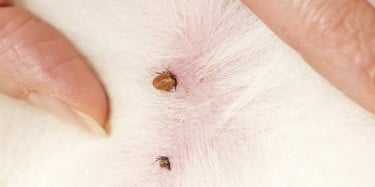
We sure know that ticks are a nuisance, ticks can’t jump or fly, they sit at the tip of grass and plants waiting to brush on a skin, before crawling to a comfortable spot, feeding on mammalian blood.
Checking your dog’s fur after walking in the woods or long grass is essential. Most ticks are harmless, but can cause discomfort to your pet. Here are things to know about ticks.
1. Ticks have four life stages: egg, larva (infant), nymph (immature), and adult (mature). All stages except the egg need to feed on a host or else the tick will die. At each stage most ticks die before they are able to feed on a host.
2. Unlike fleas, ticks take up to three years to mature to adult stage and reproduce.
3. Ticks feeds on the blood of their hosts, either humans, birds, reptiles, including domestic and wide animals. Different tick species prefer to feed on different host at different life stages, though some like the Brown Dog Ticks may feed on a particular host species.
4. Ticks infestation are common in dogs, they are also easier to prevent since there are more FDA-approved products to kill ticks on dogs. So ticks prevention products are not safe around cats, so be sure to discuss best preventive measures with your veterinarian.
Symptoms of Ticks on Dogs
1. There will be a change in voice and barking.
2. Irritation of the skin or anemia (Brown dog tick).
3. Vomiting after a tick bite.
4. Struggling to breath or rapid breathing.
5. Lethargic after a tick bite.
6. Loss of coordination in the hind legs which my progress to paralysis.
Should you notice any of this symptoms of thick bite on your pet, you should seek immediate veterinary attention.
Preventive Measures on Ticks
Avoid taking your dog through tick-infested areas, but you may also consider using a bevy of tick-repellent products to keep the buggers away. Try applying a topical insecticide directly to your dog’s skin for long-term protection.
Bath your dog with tick shampoo, you can find medicated shampoos in your local grocery or a pet store.
Be careful not to mix medications. Your vet can recommend effective tick prevention treatments such as collars, tablets and on the spot treatments to help stop the parasite attaching itself to your dog.
Ensure to check up with your vet, especially after walking through the woods or the bushes.
How to Remove Tick from Your Dog
As mentioned above, if you find a tick on your dog, it should be removed as soon as possible with tweezers or specially designed ticks removal tools.
Here are few steps on how to get ticks off your dog;
• Grab the tick adjacent to your dog’s skin, twist the tick, and then pluck the tick away from the skin using a tweezers or specially-designed tick removal tools. Be careful not to squeeze the tick’s body.
• Store the tick in a container after removal for identification by your veterinarian.
• Infested dogs should be treated with anti-tick insecticides that kill attached larvae, nymphs, and adults.
Keeping animals away from tick-prone areas is the most effective steps you can take to control tick exposure. Most ticks live in a particular microhabitats, such as tall grass or the borders between lawns and wooden areas. Destroying these microhabitats reduces the number of ticks in our environment. Removing tall trees, weeds and trimming vegetation can help protect our pets.